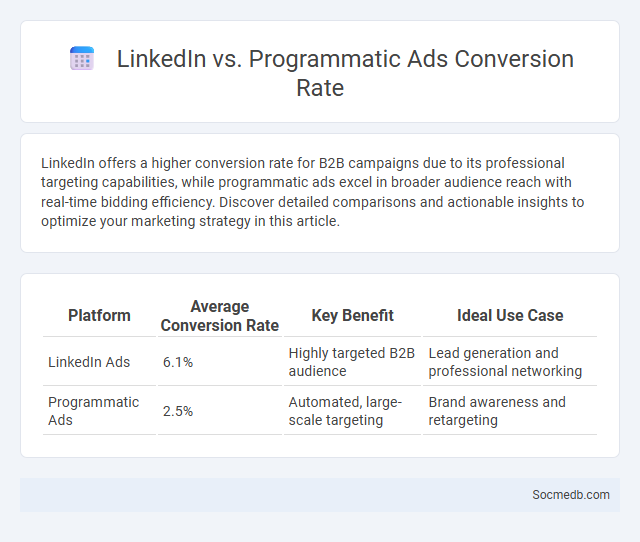
Photo illustration: LinkedIn vs Programmatic Ads Conversion Rate
LinkedIn offers a higher conversion rate for B2B campaigns due to its professional targeting capabilities, while programmatic ads excel in broader audience reach with real-time bidding efficiency. Discover detailed comparisons and actionable insights to optimize your marketing strategy in this article.
Table of Comparison
| Platform | Average Conversion Rate | Key Benefit | Ideal Use Case |
|---|---|---|---|
| LinkedIn Ads | 6.1% | Highly targeted B2B audience | Lead generation and professional networking |
| Programmatic Ads | 2.5% | Automated, large-scale targeting | Brand awareness and retargeting |
Introduction to Conversion Rates in Digital Advertising
Conversion rates in digital advertising measure the percentage of users who take a desired action, such as clicking an ad or completing a purchase, after engaging with your social media content. Effective tracking and analysis of these rates provide insight into the performance of your campaigns and help optimize targeting strategies to maximize return on investment (ROI). Understanding how social media interactions translate into conversions allows you to tailor ad creatives and placements for higher engagement and improved sales outcomes.
Overview of LinkedIn Ads Conversion Potential
LinkedIn Ads offer high conversion potential by targeting professionals based on industry, job title, and company size, ensuring precise audience engagement. With advanced features like Lead Gen Forms and Sponsored Content, advertisers can capture qualified leads and drive impactful B2B conversions. Campaigns on LinkedIn typically yield higher ROI in professional services and tech sectors due to its specialized user base and intent-driven interactions.
Programmatic Advertising: Mechanisms and Conversion Metrics
Programmatic advertising on social media leverages automated bidding systems and real-time data analytics to efficiently target specific audiences across platforms such as Facebook, Instagram, and Twitter. Key mechanisms include demand-side platforms (DSPs) and supply-side platforms (SSPs) that facilitate precise ad placement, optimizing ad spend based on user behavior and engagement patterns. Conversion metrics like click-through rate (CTR), cost per acquisition (CPA), and return on ad spend (ROAS) provide actionable insights to evaluate campaign effectiveness and maximize ROI.
Defining Conversion Rate: Key Concepts
Conversion rate measures the percentage of users who complete a desired action, such as making a purchase or signing up for a newsletter, after engaging with your social media content. This key metric helps you evaluate the effectiveness of your campaigns by tracking how well your audience responds to calls-to-action. Understanding conversion rate empowers you to optimize your strategy for higher engagement and improved return on investment.
LinkedIn Ads vs. Programmatic Ads: Direct Conversion Rate Comparison
LinkedIn Ads deliver a higher direct conversion rate for B2B campaigns compared to Programmatic Ads due to precise targeting of professionals by industry, job title, and company size. Your investment in LinkedIn Ads typically results in increased lead quality and faster conversion cycles, while Programmatic Ads provide broader reach but often lower engagement specificity. Analyzing conversion metrics reveals LinkedIn's advantage in directly influencing purchase decisions through personalized professional targeting.
Factors Influencing Conversion Rates on LinkedIn
LinkedIn conversion rates are significantly influenced by factors such as targeted audience segmentation, personalized content, and optimized call-to-action (CTA) buttons. High engagement levels correlate with the use of professional visuals, relevant industry keywords, and consistent posting schedules. Utilizing LinkedIn analytics to track user behavior and adjusting campaigns accordingly also enhances lead generation and conversion efficiency.
Elements Affecting Programmatic Ads Conversion Performance
Programmatic ads conversion performance is significantly influenced by audience targeting precision, ad placement quality, and real-time bidding efficiency. Factors such as user engagement metrics, device type, and time of day also play critical roles in optimizing conversion rates. Leveraging data analytics and machine learning algorithms enhances multiple touchpoints, driving better conversion outcomes on social media platforms.
Audience Targeting: Precision and Impact on Conversion Rates
Audience targeting in social media leverages advanced algorithms and user data to deliver highly relevant content to specific demographics, behaviors, and interests, maximizing engagement. Precise targeting enhances your campaign's efficiency by reducing ad spend on uninterested users and increasing conversion rates through tailored messaging. This strategic focus empowers marketers to optimize their ROI by connecting with the right audience at the right time on platforms like Facebook, Instagram, and LinkedIn.
Cost Efficiency: LinkedIn vs Programmatic Conversions
LinkedIn advertising offers targeted B2B marketing with higher CPC rates but delivers quality leads for professional services, optimizing cost-per-conversion in niche markets. Programmatic advertising provides scalable reach across diverse platforms with algorithm-driven bidding, often resulting in lower cost-per-acquisition but variable lead quality. Balancing LinkedIn's precision targeting against programmatic's volume efficiency is essential for maximizing ROI in conversion-focused campaigns.
Strategic Recommendations for Maximizing Ad Conversion Rates
To maximize ad conversion rates on social media, leverage precise audience targeting using detailed demographic and behavioral data to ensure ads reach high-intent users. Utilize A/B testing for creative elements and call-to-action buttons to identify the most effective messaging and design. Incorporate retargeting campaigns combined with optimized bidding strategies to increase engagement and drive higher conversion rates.
 socmedb.com
socmedb.com